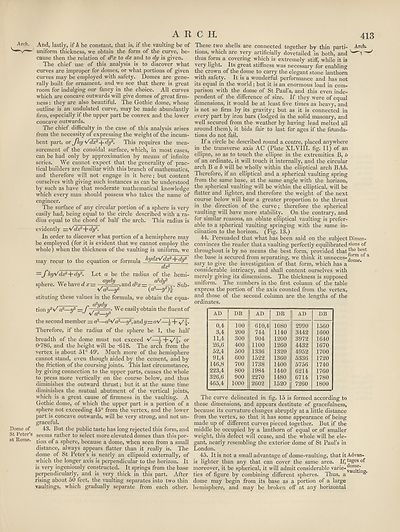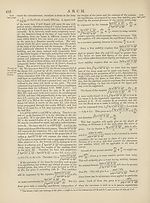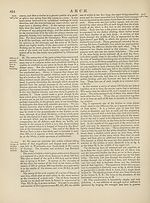Encyclopaedia Britannica > Volume 3, Anatomy-Astronomy
(421) Page 413
Download files
Complete book:
Individual page:
Thumbnail gallery: Grid view | List view

ARCH.
413
Arch. And, lastly, if A be constant, that is, if the vaulting be of
■’V-"*' uniform thickness, we obtain the form of the curve, be¬
cause then the relation of cPx to dx and to dy is given.
The chief use of this analysis is to discover what
curves are improper for domes, or what portions of given
curves may be employed with safety. Domes are gene¬
rally built for ornament, and we see that there is great
room for indulging our fancy in the choice. All curves
which are concave outwards will give domes of great firm¬
ness : they are also beautiful. The Gothic dome, whose
outline is an undulated curve, may be made abundantly
firm, especially if the upper part be convex and the lower
concave outwards.
The chief difficulty in the case of this analysis arises
from the necessity of expressing the weight of the incum¬
bent part, or fhy Vdoc1 -)- dy2. This requires the mea¬
surement of the conoidal surface, which, in most cases,
can be had only by approximation by means of infinite
series. We cannot expect that the generality of prac¬
tical builders are familiar with this branch of mathematics,
and therefore will not engage in it here; but content
ourselves with giving such instances as can be understood
by such as have that moderate mathematical knowledge
which every man should possess who takes the name of
engineer.
The surface of any circular portion of a sphere is very
easily had, being equal to the circle described with a ra¬
dius equal to the chord of half the arch. This radius is
evidently -Vdofi-^-dy2.
In order to discover what portion of a hemisphere may
be employed (for it is evident that we cannot employ the
whole) when the thickness of the vaulting is uniform, we
may recur to the equation or formula hydxVd.xr dy2
-'fhyVdxP-^rdy2. Let a be the radius of the hemi¬
sphere. We have dx~ — and d-x — 7-fSub-
Vcd—y* («2—/)!
stituting these values in the formula, we obtain the equa-
_ cPvdv
tion a2—y2 — f , -• We easily obtain the fluent of
v a2—y1
the second member = a3—aVa2—if, and?/=«V/—| + \/f*
Therefore, if the radius of the sphere be 1, the half
Dome of
St Peter’s
at Rome.
breadth of the dome must not exceed V—\ or
0*786, and the height will be *618. The arch from the
vertex is about 51° 49'. Much more of the hemisphere
cannot stand, even though aided by the cement, and by
the friction of the coursing joints. This last circumstance,
by giving connection to the upper parts, causes the whole
to press more vertically on the course below, and thus
diminishes the outward thrust; but it at the same time
diminishes the mutual abutment of the vertical joints,
which is a great cause of firmness in the vaulting. A
Gothic dome, of which the upper part is a portion of a
sphere not exceeding 45° from the vertex, and the lower
part is concave outwards, will be very strong, and not un¬
graceful.
43. But the public taste has long rejected this form, and
seems rather to select more elevated domes than this por¬
tion of a sphere, because a dome, when seen from a small
distance, always appears flatter than it really is. The
dome of St Peter’s is nearly an ellipsoid externally, of
which the longer axis is perpendicular to the horizon. It
is very ingeniously constructed. It springs from the base
perpendicularly, and is very thick in this part. After
rising about 50 feet, the vaulting separates into two thin
vaultings, which gradually separate from each other.
These two shells are connected together by thin parti- Arch,
tions, which are very artificially dovetailed in both, and
thus form a covering which is extremely stiff, while it is
very light. Its great stiffness was necessary for enabling
the crown of the dome to carry the elegant stone lanthorn
with safety. It is a wonderful performance and has not
its equal in the world ; but it is an enormous load in com¬
parison with the dome of St Paul’s, and this even inde¬
pendent of the difference of size. If they were of equal
dimensions, it would be at least five times as heavy, and
is not so firm by its gravity; but as it is connected in
every part by iron bars (lodged in the solid masonry, and
well secured from the weather by having lead melted all
around them), it bids fair to last for ages if the founda¬
tions do not fail.
If a circle be described round a centre, placed anywhere
in the transverse axis AC (Plate XLVIII. fig. 11) of an
ellipse, so as to touch the ellipse in the extremities B, b
of an ordinate, it will touch it internally, and the circular
arch B a A will be wholly within the elliptical arch BAA.
Therefore, if an elliptical and a spherical vaulting spring
from the same base, at the same angle with the horizon,
the spherical vaulting will be within the elliptical, will be
flatter and lighter, and therefore the weight of the next
course below will bear a greater proportion to the thrust
in the direction of the curve; therefore the spherical
vaulting will have more stability. On the contrary, and
for similar reasons, an oblate elliptical vaulting is prefer¬
able to a spherical vaulting springing with the same in¬
clination to the horizon. (Fig. 13.)
44. Persuaded that what has been said on the subject Dimen-
convinces the reader that a vaulting perfectly equilibrated sions of
throughout is by no means the best form, provided that J.he best
the base is secured from separating, we think it u0116068**^,1,^0 1
sary to give the investigation of that form, which has a
considerable intricacy, and shall content ourselves with
merely giving its dimensions. The thickness is supposed
uniform. The numbers in the first column of the table
express the portion of the axis counted from the vertex,
and those of the second column are the lengths of the
ordinates.
The curve delineated in fig. 15 is formed according to
these dimensions, and appears destitute of gracefulness,
because its curvature changes abruptly at a little distance
from the vertex, so that it has some appearance of being
made up of different curves pieced together. But if the
middle be occupied by a lanthorn of equal or of smaller
weight, this defect will cease, and the whole will be ele¬
gant, nearly resembling the exterior dome of St Paul’s in
London.
45. It is not a small advantage of dome-vaulting, thatitAdvan-
is lighter than any that can cover the same area. If, tages of
moreover, it be spherical, it will admit considerable varie-^om.®.'
ties of figure by combining different spheres. Thus, a
dome may begin from its base as a portion of a large
hemisphere, and may be broken off at any horizontal
413
Arch. And, lastly, if A be constant, that is, if the vaulting be of
■’V-"*' uniform thickness, we obtain the form of the curve, be¬
cause then the relation of cPx to dx and to dy is given.
The chief use of this analysis is to discover what
curves are improper for domes, or what portions of given
curves may be employed with safety. Domes are gene¬
rally built for ornament, and we see that there is great
room for indulging our fancy in the choice. All curves
which are concave outwards will give domes of great firm¬
ness : they are also beautiful. The Gothic dome, whose
outline is an undulated curve, may be made abundantly
firm, especially if the upper part be convex and the lower
concave outwards.
The chief difficulty in the case of this analysis arises
from the necessity of expressing the weight of the incum¬
bent part, or fhy Vdoc1 -)- dy2. This requires the mea¬
surement of the conoidal surface, which, in most cases,
can be had only by approximation by means of infinite
series. We cannot expect that the generality of prac¬
tical builders are familiar with this branch of mathematics,
and therefore will not engage in it here; but content
ourselves with giving such instances as can be understood
by such as have that moderate mathematical knowledge
which every man should possess who takes the name of
engineer.
The surface of any circular portion of a sphere is very
easily had, being equal to the circle described with a ra¬
dius equal to the chord of half the arch. This radius is
evidently -Vdofi-^-dy2.
In order to discover what portion of a hemisphere may
be employed (for it is evident that we cannot employ the
whole) when the thickness of the vaulting is uniform, we
may recur to the equation or formula hydxVd.xr dy2
-'fhyVdxP-^rdy2. Let a be the radius of the hemi¬
sphere. We have dx~ — and d-x — 7-fSub-
Vcd—y* («2—/)!
stituting these values in the formula, we obtain the equa-
_ cPvdv
tion a2—y2 — f , -• We easily obtain the fluent of
v a2—y1
the second member = a3—aVa2—if, and?/=«V/—| + \/f*
Therefore, if the radius of the sphere be 1, the half
Dome of
St Peter’s
at Rome.
breadth of the dome must not exceed V—\ or
0*786, and the height will be *618. The arch from the
vertex is about 51° 49'. Much more of the hemisphere
cannot stand, even though aided by the cement, and by
the friction of the coursing joints. This last circumstance,
by giving connection to the upper parts, causes the whole
to press more vertically on the course below, and thus
diminishes the outward thrust; but it at the same time
diminishes the mutual abutment of the vertical joints,
which is a great cause of firmness in the vaulting. A
Gothic dome, of which the upper part is a portion of a
sphere not exceeding 45° from the vertex, and the lower
part is concave outwards, will be very strong, and not un¬
graceful.
43. But the public taste has long rejected this form, and
seems rather to select more elevated domes than this por¬
tion of a sphere, because a dome, when seen from a small
distance, always appears flatter than it really is. The
dome of St Peter’s is nearly an ellipsoid externally, of
which the longer axis is perpendicular to the horizon. It
is very ingeniously constructed. It springs from the base
perpendicularly, and is very thick in this part. After
rising about 50 feet, the vaulting separates into two thin
vaultings, which gradually separate from each other.
These two shells are connected together by thin parti- Arch,
tions, which are very artificially dovetailed in both, and
thus form a covering which is extremely stiff, while it is
very light. Its great stiffness was necessary for enabling
the crown of the dome to carry the elegant stone lanthorn
with safety. It is a wonderful performance and has not
its equal in the world ; but it is an enormous load in com¬
parison with the dome of St Paul’s, and this even inde¬
pendent of the difference of size. If they were of equal
dimensions, it would be at least five times as heavy, and
is not so firm by its gravity; but as it is connected in
every part by iron bars (lodged in the solid masonry, and
well secured from the weather by having lead melted all
around them), it bids fair to last for ages if the founda¬
tions do not fail.
If a circle be described round a centre, placed anywhere
in the transverse axis AC (Plate XLVIII. fig. 11) of an
ellipse, so as to touch the ellipse in the extremities B, b
of an ordinate, it will touch it internally, and the circular
arch B a A will be wholly within the elliptical arch BAA.
Therefore, if an elliptical and a spherical vaulting spring
from the same base, at the same angle with the horizon,
the spherical vaulting will be within the elliptical, will be
flatter and lighter, and therefore the weight of the next
course below will bear a greater proportion to the thrust
in the direction of the curve; therefore the spherical
vaulting will have more stability. On the contrary, and
for similar reasons, an oblate elliptical vaulting is prefer¬
able to a spherical vaulting springing with the same in¬
clination to the horizon. (Fig. 13.)
44. Persuaded that what has been said on the subject Dimen-
convinces the reader that a vaulting perfectly equilibrated sions of
throughout is by no means the best form, provided that J.he best
the base is secured from separating, we think it u0116068**^,1,^0 1
sary to give the investigation of that form, which has a
considerable intricacy, and shall content ourselves with
merely giving its dimensions. The thickness is supposed
uniform. The numbers in the first column of the table
express the portion of the axis counted from the vertex,
and those of the second column are the lengths of the
ordinates.
The curve delineated in fig. 15 is formed according to
these dimensions, and appears destitute of gracefulness,
because its curvature changes abruptly at a little distance
from the vertex, so that it has some appearance of being
made up of different curves pieced together. But if the
middle be occupied by a lanthorn of equal or of smaller
weight, this defect will cease, and the whole will be ele¬
gant, nearly resembling the exterior dome of St Paul’s in
London.
45. It is not a small advantage of dome-vaulting, thatitAdvan-
is lighter than any that can cover the same area. If, tages of
moreover, it be spherical, it will admit considerable varie-^om.®.'
ties of figure by combining different spheres. Thus, a
dome may begin from its base as a portion of a large
hemisphere, and may be broken off at any horizontal
Set display mode to:
![]() Universal Viewer |
Universal Viewer | ![]() Mirador |
Large image | Transcription
Mirador |
Large image | Transcription
Images and transcriptions on this page, including medium image downloads, may be used under the Creative Commons Attribution 4.0 International Licence unless otherwise stated. ![]()
| Encyclopaedia Britannica > Encyclopaedia Britannica > Volume 3, Anatomy-Astronomy > (421) Page 413 |
|---|
| Permanent URL | https://digital.nls.uk/193762821 |
|---|
| Attribution and copyright: |
|
|---|---|
| Shelfmark | EB.16 |
|---|---|
| Description | Ten editions of 'Encyclopaedia Britannica', issued from 1768-1903, in 231 volumes. Originally issued in 100 weekly parts (3 volumes) between 1768 and 1771 by publishers: Colin Macfarquhar and Andrew Bell (Edinburgh); editor: William Smellie: engraver: Andrew Bell. Expanded editions in the 19th century featured more volumes and contributions from leading experts in their fields. Managed and published in Edinburgh up to the 9th edition (25 volumes, from 1875-1889); the 10th edition (1902-1903) re-issued the 9th edition, with 11 supplementary volumes. |
|---|---|
| Additional NLS resources: |
|

